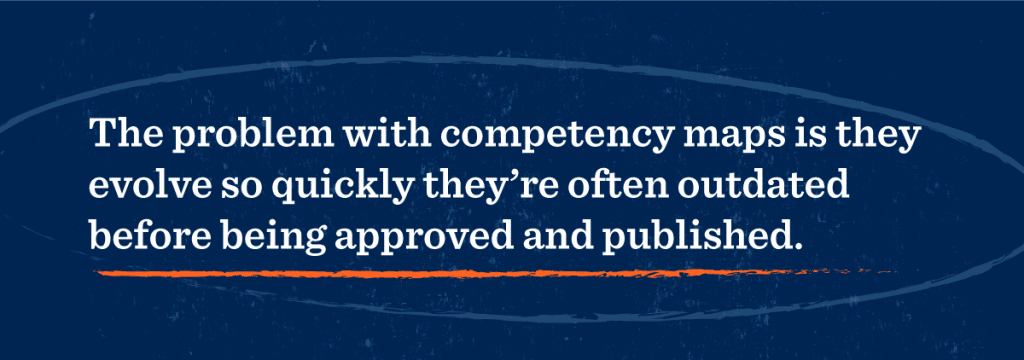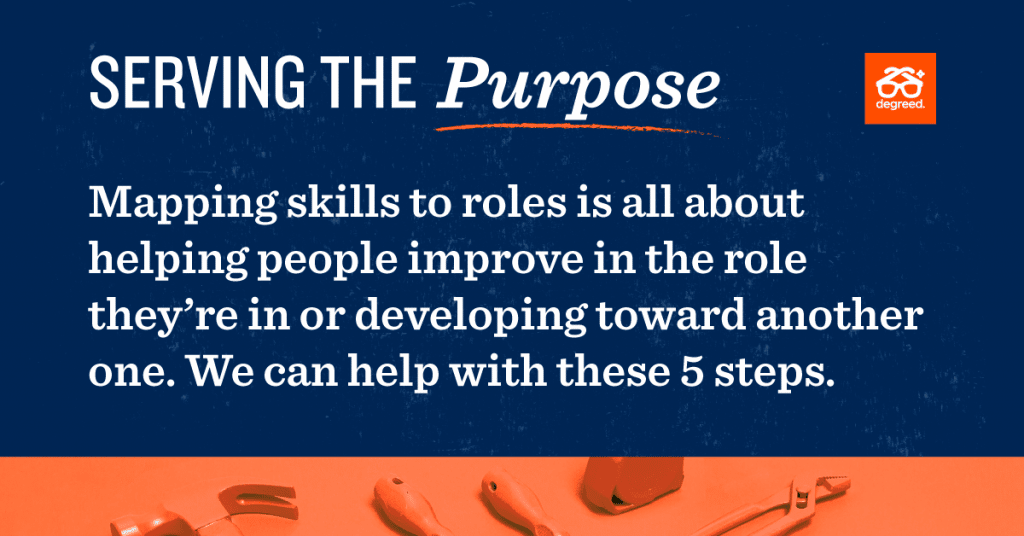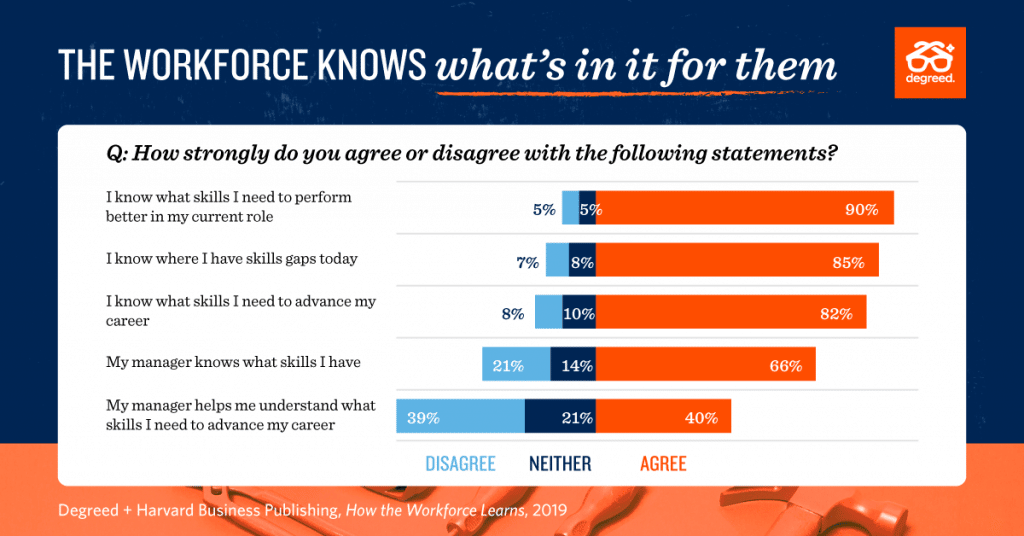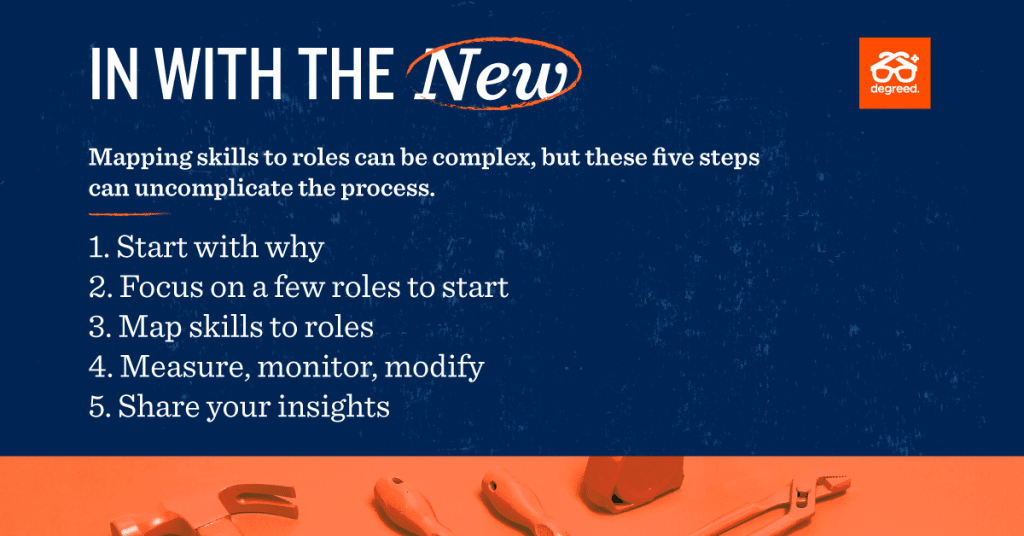This article is based on a presentation from our annual conference, Degreed LENS. Find the full video of the presentation at the bottom of this page.
By now most of us have caught on to the idea that talking about skills is cool, and many companies are simply replacing the word learning with skills. It reminds me of the late-90’s when department names changed from Training to Learning and Development.
While the idea of skills is taking over the L&D world, many professionals are facing challenges in reconciling this idea with their companies’ pre-existing competency models.
Getting With the Times
As a recovering L&Der, I have to acknowledge that this idea of skills isn’t exactly new. In many organizations, the competency model has been around for decades, but competencies of the past don’t match the skills needed today — as evidenced by the growing skills gap.
The problem with competency models is they evolve so quickly, they’re often outdated before being approved and published. And who really knows how to measure the broad statements they often contain, such as “treats customers with empathy and kindness while expediently resolving their issues”? Maybe that’s why organizations also have committees to calibrate the resulting competency measurement processes.

Another challenge is that competency models often exist in several layers: company values, leadership competencies, professional competencies, functional competencies, and finally, those critical few things that make individuals superstars at their jobs — some of which are very difficult to quantify. When looking at an individual, we often have to understand the context and then sift through the layers and webs of what might make them unique or successful.
Consider how competency models are used today. We only talk about them during hiring, promotions, performance reviews, and maybe for succession planning. The challenge with those times is they’re all high-pressure moments. It’s nearly impossible to be completely honest and accurate in measuring abilities upon which your job, career, and potential promotion are based at that moment.
Putting Skills on the Map
Okay, so you understand the problem, now it’s time to work on a solution. Mapping skills to roles is all about helping people improve in the role they’re in or developing toward another one. Once you’ve mapped, then you measure, modify, and share what you’re learning with the data. We can help with these 5 steps.

1. Start with Why
This is the fundamental business reason you’re measuring skills. Need some inspiration? Check out why these three companies are focused on skills.
For most organizations, the main driver is growth, whether that is in size, in new markets, or in new products and services to future-proof your organization.
Don’t stop there, though. Remember that you have to get this data from people. And to get the most accurate data, it’s best to avoid those highly-pressurized moments we talked about earlier. Another best practice is to identify a “why” for each individual, which is often a version of career progression, especially if it occurs within the organization (think internal mobility).
2. Focus on a Few Roles to Start
Remember that one of the reasons competency models don’t work is their complexity. They’re both layered and wordy, so let’s not repeat that mistake. When crafting your solution, focus on a few critical roles to start. Maybe you start with growth roles or high-performing departments — even a horizontal role, like a manager or business analyst. Or perhaps you focus on important skills for new hires, like going back to the basics.
Let’s be clear, you should measure skills as broadly as possible. The more data, the better. This is where your skills should be multiplying. My favorite skills stories are those of unintended insights, such as our own insight that years of experience don’t correlate to expertise. So while you’re focused on a few roles to map, make sure that you encourage your entire organization to identify and measure their skills.
3. Map Skills to Roles
After selecting a handful of crucial roles, it’s time to map skills to them. Sounds easy, right? It can be but there are a few common challenges:
Too Many: Recall where we went off the road with competencies and avoid doing too much. While you’ll have the ability to identify and add lots of skills for each role, the outcome of that approach is that you’ll have lots of data to sift through. This makes it challenging to hit the goal identified in step one. In other words, it will make it difficult to glean immediate insights.
Non-Critical: Related to the “too many” dilemma, I often see organizations trying to be overly inclusive in their skills mapping. The reality is that every one of us is a complex system of skills. Some of these skills help us to be successful in our current role, others may be completely unrelated to the current role, and some are supporting — but maybe not critical. It’s the last group that organizations might include when they really aren’t necessary. You can safely assume that anyone in a customer-facing role needs communication skills but there’s no need to list that on your map unless you truly see a need for upskilling for that skill in these roles (in which case we’re likely in need of a completely different conversation).
Top-Down: Our recent research with Harvard Business Publishing Corporate Learning on How the Workforce Learns shows that our employees know their skills and skills gaps. So why aren’t we asking them? You’ll get better input along with better output to meet your goal.

4. Measure, Monitor, Modify
You need to measure, but also monitor often and modify based on what you’re seeing. Say you’re looking at project management, and noticing that everyone’s level is the same. You measured and monitored, but in order to get insight, you need to modify. Perhaps project management isn’t the skill that distinguishes great performance (and great performance is what you need to meet your goal). So remove it and find the skills that are driving your business forward.
5. Share Your Insights
This one may seem obvious but too often we stop at the measuring stage, so we don’t fully realize the impact of our insights. How many of you are still sharing metrics that look like percent completions, attendance, learning hours, or satisfaction? How about adding skill insights, and more importantly, what you can do about it? Remember that insight we found regarding years of experience? It can lead to changes in job requirements and the opening of talent pools. That can lead to more growth! Find those connections in your data and share them, far and wide.
Putting It All Into Practice
These five steps sound great but this process is complex and can be difficult to visualize without translating it to real situations. Let’s work through an example of what it would look like in practice:
1. Start With Why
Profit margins are shrinking, so we’ve done some soul searching and we know we need to retool our processes and upskill our people toward greater efficiency. People in our organization have expressed a desire for greater clarity in the career growth available within the organization given the shift in the strategy.
2. Focus on a Few Roles to Start
We’ll focus on three horizontal roles that have the most data and impact on process efficiency: project managers, business analysts, and organizational process designers. We also know that when changes are introduced to processes, managers will be the linchpins to success. So, we’ll add “manager” as a role.
3. Map Skills to Roles
In talking with experts in each role, we’ve identified four common critical skills related to increased efficiency: process improvement, process automation, data analysis, and prioritizing tasks. For managers, we identify change management, coaching, and giving feedback.
4. Measure, Monitor, Modify
We ask everyone in each role to complete a Skill Review to both gather our initial dataset and create a benchmark on which we can measure our efforts. In the data, we notice that organizational process designers are lagging in process automation, compared to business analysts. We pair one person in each role for job shadowing and idea-sharing. We also notice that across the board, the data for prioritizing tasks is both at the expected level and similar across the board, so we decide to remove that skill from our map. In the manager group, we find managers who are strong in each skill, and also several who are weak across the board. We build time-bound upskilling plans and measure again at the end. Managers who are still weak are moved into non-management roles, as each of the three skills will be critical to our organization’s success.
5. Share Your Insights
Each month, we report on the initiative and results. The first reports highlighted our areas of focus and skills-to-role maps. In later updates, we shared the surprise on process automation and our solution, as well as the removal of prioritizing tasks. As the job shadowing progresses, we measure again and notice an increase in skill level for our organizational process designers. The manager changes are also in place, and the replacement managers demonstrate the appropriate skill levels. The improvements correspond with a 10% efficiency in operational processes, which should have a corresponding impact on profits.

That’s it! You now have the power to find impactful insights within your organization. To get help mapping out your skills strategy, contact Degreed here.
